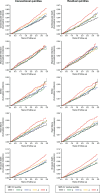Impact of seasonal blood pressure changes on visit-to-visit blood pressure variability and related cardiovascular outcomes
- PMID: 38690947
- PMCID: PMC11198955
- DOI: 10.1097/HJH.0000000000003759
Impact of seasonal blood pressure changes on visit-to-visit blood pressure variability and related cardiovascular outcomes
Abstract
Background: Visit-to-visit blood pressure (BP) variability associates with an increased risk of cardiovascular events. We investigated the role of seasonal BP modifications on the magnitude of BP variability and its impact on cardiovascular risk.
Methods: In 25 390 patients included in the ONTARGET and TRANSCEND trials, the on-treatment systolic (S) BP values obtained by five visits during the first two years of the trials were grouped according to the month in which they were obtained. SBP differences between winter and summer months were calculated for BP variability quintiles (Qs), as quantified by the coefficient of variation (CV) of on-treatment mean SBP from the five visits. The relationship of BP variability with the risk of cardiovascular events and mortality was assessed by the Cox regression model.
Results: SBP was approximately 4 mmHg lower in summer than in winter regardless of confounders. Winter/summer SBP differences contributed significantly to each SBP-CV quintile. Increase of SBP-CV from Q1 to Q5 was associated with a progressive increase in the adjusted hazard ratio (HR) of the primary endpoint of the trials, i.e. morbid and fatal cardiovascular events. This association was even stronger after removal of the effect of seasonality from the calculation of SBP-CV. A similar trend was observed for secondary endpoints.
Conclusions: Winter/summer SBP differences significantly contribute to visit-to-visit BP variability. However, this contribution does not participate in the adverse prognostic significance of visit-to-visit BP variations, which seems to be more evident after removal of the BP effects of seasonality from visit-to-visit BP variations.
Copyright © 2024 Wolters Kluwer Health, Inc. All rights reserved.
Conflict of interest statement
The corresponding author has nothing to disclose with regard to the present paper. This is the case also for the remaining authors.
Data availability statement: The data underlying this article will be shared on reasonable request to the corresponding author.
Figures







Similar articles
-
Comparison between visit-to-visit office and 24-h blood pressure variability in treated hypertensive patients.J Hypertens. 2024 Jan 1;42(1):161-168. doi: 10.1097/HJH.0000000000003582. Epub 2023 Oct 9. J Hypertens. 2024. PMID: 37850964 Free PMC article.
-
Blood pressure targets for hypertension in people with diabetes mellitus.Cochrane Database Syst Rev. 2013 Oct 30;2013(10):CD008277. doi: 10.1002/14651858.CD008277.pub2. Cochrane Database Syst Rev. 2013. PMID: 24170669 Free PMC article.
-
Arm Based on LEg blood pressures (ABLE-BP): can systolic ankle blood pressure measurements predict systolic arm blood pressure? An individual participant data meta-analysis from the INTERPRESS-IPD Collaboration.BMJ Open. 2025 Jun 11;15(6):e094389. doi: 10.1136/bmjopen-2024-094389. BMJ Open. 2025. PMID: 40500230 Free PMC article.
-
Achieving a Systolic Blood Pressure Below 130 mmHg Reduces the Incidence of Cardiovascular Events in Hypertensive Patients with Echocardiographic Left Ventricular Hypertrophy.J Pharmacol Exp Ther. 2024 Jun 21;390(1):4-10. doi: 10.1124/jpet.123.001952. J Pharmacol Exp Ther. 2024. PMID: 38135511 Free PMC article.
-
Blood pressure targets for hypertension in older adults.Cochrane Database Syst Rev. 2017 Aug 8;8(8):CD011575. doi: 10.1002/14651858.CD011575.pub2. Cochrane Database Syst Rev. 2017. Update in: Cochrane Database Syst Rev. 2024 Dec 17;12:CD011575. doi: 10.1002/14651858.CD011575.pub3. PMID: 28787537 Free PMC article. Updated.
Cited by
-
Blood pressure variability: a review.J Hypertens. 2025 Jun 1;43(6):929-938. doi: 10.1097/HJH.0000000000003994. Epub 2025 Mar 10. J Hypertens. 2025. PMID: 40084481 Free PMC article. Review.
-
Blood Pressure Variability and Low-Grade Inflammation in Pediatric Patients with Primary Hypertension.J Clin Med. 2025 Aug 13;14(16):5737. doi: 10.3390/jcm14165737. J Clin Med. 2025. PMID: 40869561 Free PMC article.
References
-
- Mancia G, Messerli F, Bakris G, Zhou Q, Champion A, Pepine CJ. Blood pressure control and improved cardiovascular outcomes in the International Verapamil SR-Trandolapril Study. Hypertension 2007; 50:299–305. - PubMed
-
- Mancia G, Schumacher H, Redon J, Verdecchia P, Schmieder R, Jennings G, et al. . Blood pressure targets recommended by guidelines and incidence of cardiovascular and renal events in the Ongoing Telmisartan Alone and in combination with Ramipril Global Endpoint Trial (ONTARGET). Circulation 2011; 124:1727–1736. - PubMed
-
- Mancia G, Kjeldsen SE, Zappe DH, Holzhauer B, Hua TA, Zanchetti A, et al. . Cardiovascular outcomes at different on treatment blood pressures in the hypertensive patients of the VALUE trial. Eur Heart J 2016; 37:955–964. - PubMed
-
- Rothwell PM, Howard SC, Dolan E, O’Brien E, Dobson JE, Dalhof B, et al. . Prognostic significance of visit-to-visit variability, maximum systolic blood pressure, and episodic hypertension. Lancet 2010; 375:895–905. - PubMed
-
- Kikuya M, Ohkubo T, Metoki H, Asayama K, Hara A, Obara T, et al. . Day-by-day variability of blood pressure and heart rate at home as a novel predictor of prognosis: the Ohasama study. Hypertension 2008; 52:1045–1050. - PubMed
MeSH terms
LinkOut - more resources
Full Text Sources

